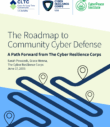Filter & Sort
| Date | Type | Research Item | Topics |
|---|---|---|---|
|
June 17, 2025 |
White Paper |

The Roadmap to Community Cyber Defense: A Path Forward from the Cyber Resilience CorpsBy: Sarah Powazek, Grace Menna Community organizations — including nonprofits, hospitals, schools, local utilities, city governments, and small businesses — deliver vital services to the public, but they are often the least prepared to… |
|
|
May 8, 2025 |
White Paper |

Survey of Search Engine Safeguards and their Applicability for AIBy: Evan R. Murphy, Nada Madkour, Deepika Raman, Krystal Jackson, Jessica Newman, Survey of Search Engine Safeguards and their Applicability for AI A new research paper from the Center for Long-Term Cybersecurity examines how safeguards designed for search engines could be adopted by developers of AI systems like ChatGPT. The… |
artificial intelligence (AI)data sharingdigital harmsengineeringhomeland securitymachine learning (ML)misinformationnational security |
|
April 16, 2025 |
White Paper |

The South Korean Digital Paradox: How South Korea’s Internet Development Model Creates Unique Cybersecurity VulnerabilitiesBy: Nick Merrill, The South Korean Digital Paradox: How South Korea’s Internet Development Model Creates Unique Cybersecurity Vulnerabilities South Korea is home to one of the world’s most robust digital infrastructures, largely as a result of a government-led development model that has favored domestic technologies. Nearly… |
governanceinfrastructureinternet fragmentationmisinformationpolicyriskscenarios |
|
March 31, 2025 |
White Paper |

Managing Commercial Spyware Through Export Controls: Lessons Learned from the Wassenaar ExperienceBy: Elaine Korzak A new white paper from the Center for Long-Term Cybersecurity explores the use of international export controls to limit the dissemination of commercial spyware technologies. The paper, “Managing… |
digital harmsgovernancelaw enforcementnational securitypolicyprivacysurveillance |
|
February 3, 2025 |
White Paper |

Intolerable Risk Threshold Recommendations for Artificial IntelligenceBy: Deepika Raman, Nada Madkour, Evan R. Murphy, Krystal Jackson, Jessica Newman January has already seen the release of new frontier models that are creating waves with unprecedented innovation in their development and uplift in their capabilities. Simultaneously, we are… |
|
|
January 29, 2025 |
White Paper |

Impacts of Open Radio Access Networks for Operators, Policymakers, and ConsumersBy: Jon Metzler A new white paper published by the UC Berkeley Center for Long-Term Cybersecurity examines the implications of “open radio access networks,” or Open RAN, a movement focused… |
|
|
January 28, 2025 |
White Paper |

AI Risk-Management Standards Profile for General-Purpose AI (GPAI) and Foundation ModelsBy: Anthony Barrett, Jessica Newman, Brandie Nonnecke, Nada Madkour, Dan Hendrycks, Evan R. Murphy, Krystal Jackson, Deepika Raman The first annual update to the AI Risk-Management Standards Profile for General-Purpose AI Systems (GPAIS) and Foundation Models (Version 1.1) has been published by a team of researchers… |
|
|
November 19, 2024 |
White Paper |

CyberCAN: Cybersecurity for Cities and NonprofitsBy: Sarah Powazek, Shannon Pierson A new CLTC report provides guidance to help government leaders in San Francisco and other cities more effectively support the digital security of local nonprofits. The report, “CyberCAN:… |
|
|
October 31, 2024 |
White Paper |

Resistance to Text-to-Image Generators in Creator CommunitiesText-to-image generators like DALL-E have sparked controversy among artistic creators, who are concerned about how generative artificial intelligence (Gen AI) models have been trained with copyright-protected materials. A… |
|
|
October 1, 2024 |
White Paper |

Cyber Resilience and Social Equity: Twin Pillars of a Sustainable Energy FutureBy: Emma Stewart, Remy Stolworthy, Virginia Wright A report published by the Center for Long-Term Cybersecurity, Cyber Resilience and Social Equity: Twin Pillars of a Sustainable Energy Future, examines the importance of cybersecurity in ensuring equitable access to energy. In an era of worsening cybersecurity threats, the paper advocates for “sustainable energy delivery systems that ensure robust defenses without compromising the goals of reducing energy poverty and ensuring energy security.” |
digital harmshomeland securityinfrastructurepolicypublic interest cybersecurity |

